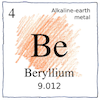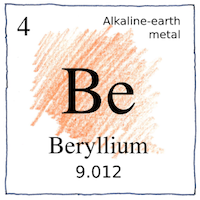Paris, Berlin—Louis Nicolas Vauquelin,
Friedrich Wöhler,
Antoine Bussy
elements

|
Beryllium
Beryls and emeralds people thought are suspiciously similar. Chemists confirmed they have the same structure but couldn’t explain why they shine with different colors. Louis Nicolas Vauquelin had found chromium in rubies so people asked him about beryls and emeralds. Vauquelin found, aside from a little chromium in emerald, both beryl and emerald contained a new element whose oxide he named glucina. Thirty years later, Friedrich Wöhler and Antoine Bussy independently isolated the metal by reacting potassium and beryllium chloride.
Atomic number 4
Paul Lebeau produced the first pure beryllium using electrolysis in 1898 but commercial production wasn’t successful until 1932. * Beryllium rocket nozzles. Beryllium mirrors for space telescopes. Beryllium in high-frequency speaker drivers. Beryllium phosphors in early fluorescent lights. Beryllium windows transparent to X-rays. Beryllium-copper alloys six times harder than copper. * Beryllium is highly toxic. Many uses of beryllium are discontinued. Avoiding contact or breathing beryllium dust is highly recommended.
Gems
Aluminum cyclosilicate crystals with certain trace elements. Aquamarine and maxixe, green-blue, and aquamarine chrysolite, pale yellow, from different iron ions. Emerald, green, from chromium or vanadium. Heliodor, greenish-yellow, and golden beryl, golden yellow, from iron ions. Morganite, light pink to rose, and red beryl or bixbite, red, from manganese ions. Goshenite, clear.
Stuff with flaws
Synthetic emeralds have no flaws. Some might feel small inclusions don’t reduce a natural emerald’s value but show its age and natural origin. If only the same were true of spots and wrinkles.



Vauquelin named beryllium glucina because its salts taste sweet, but Martin Heinrich Klaproth objected because yttria salts also taste sweet. This was an age when chemists routinely tasted their salts and later died of mysterious causes.
Johan Gadolin had isolated beryllium oxide from gandolite when he discovered yttrium; however, he mistook it for aluminium oxide.
See also in The book of science:
Readings in wikipedia:
Other readings: